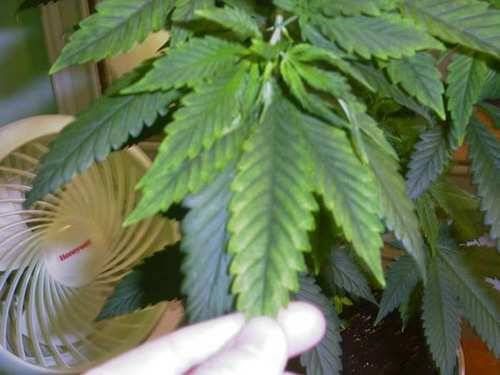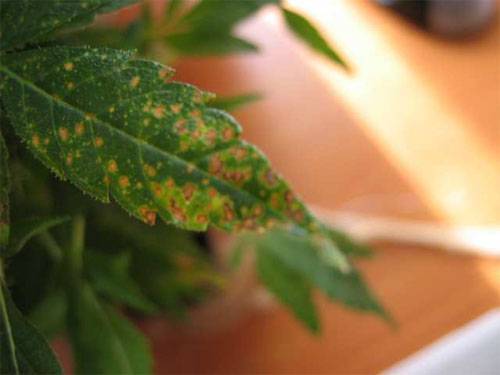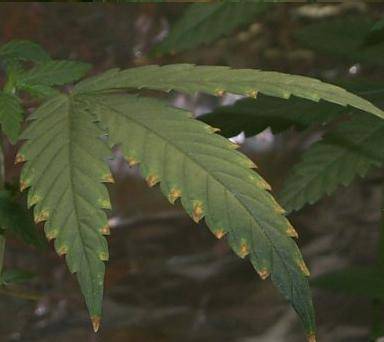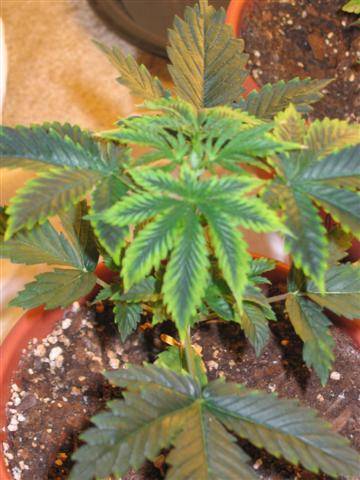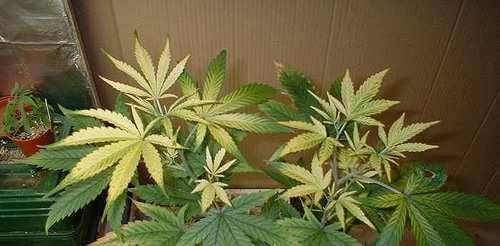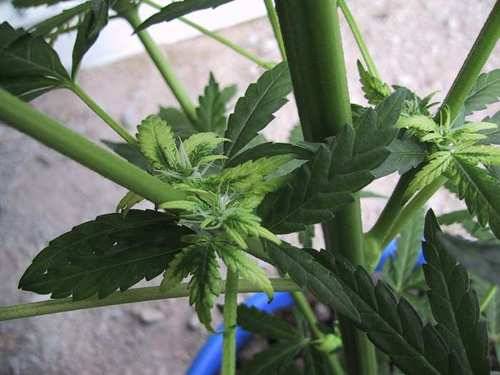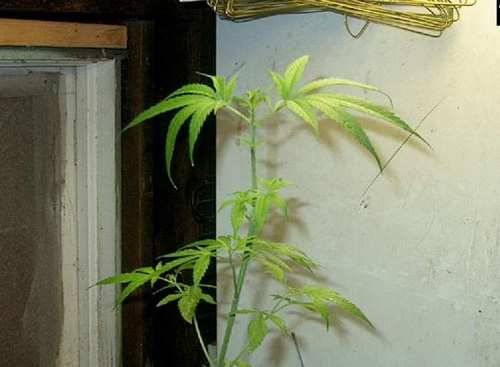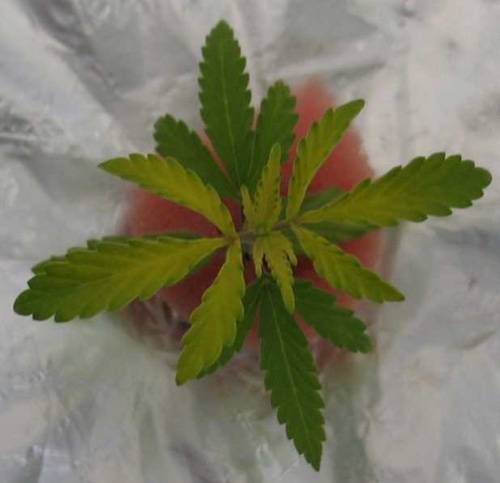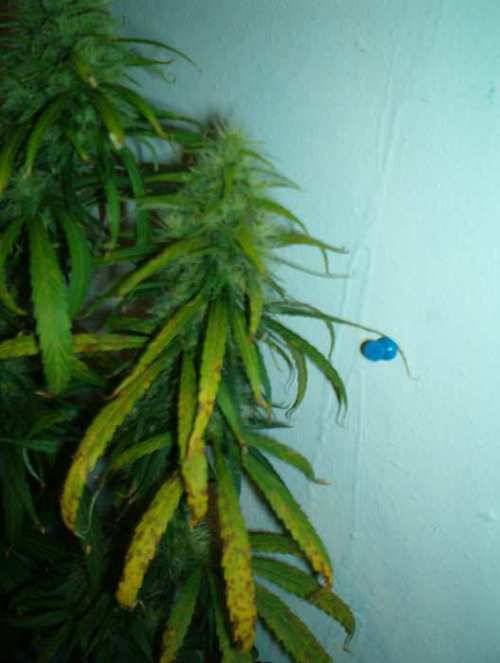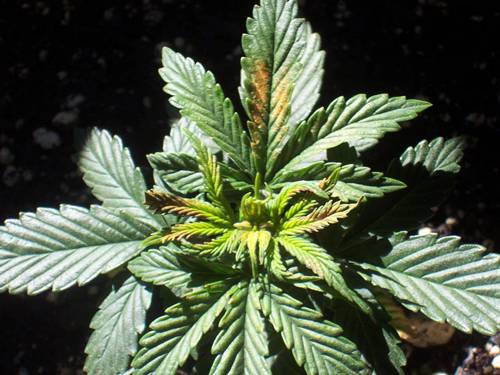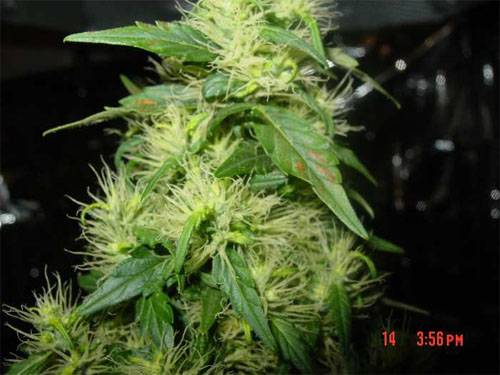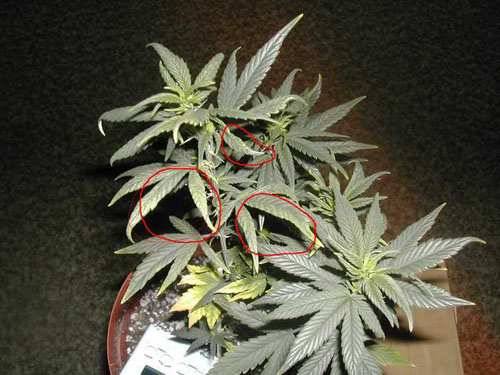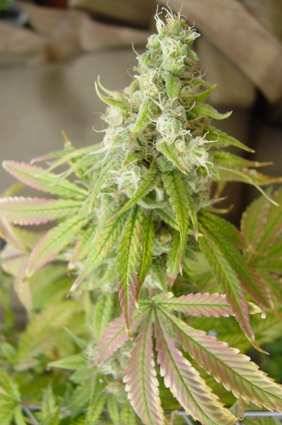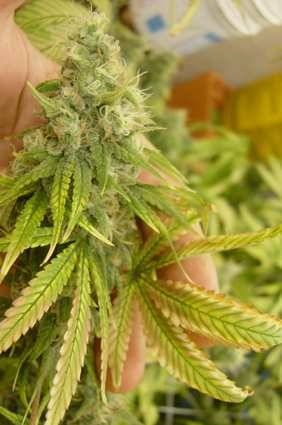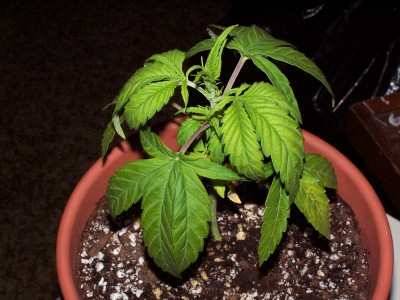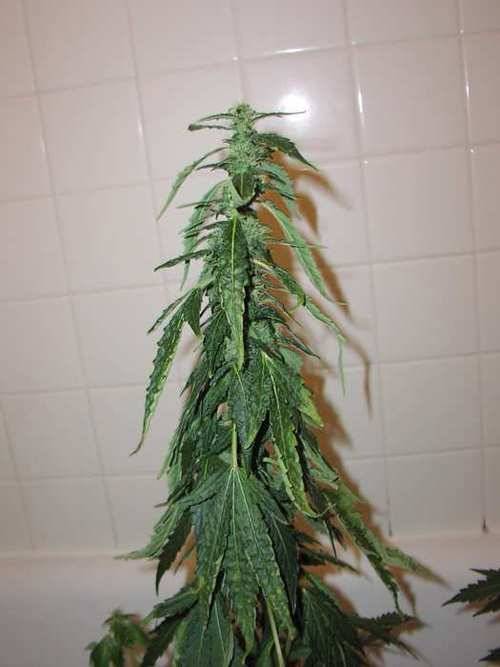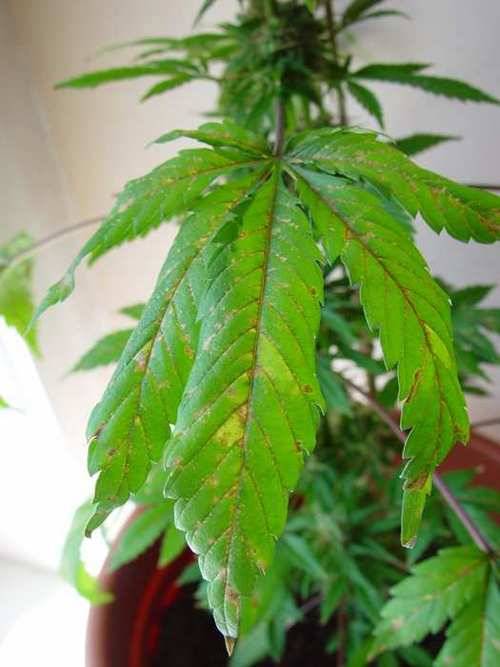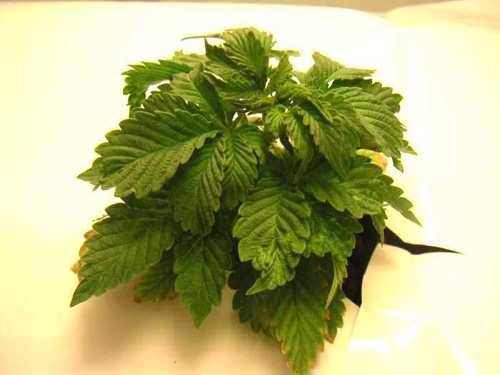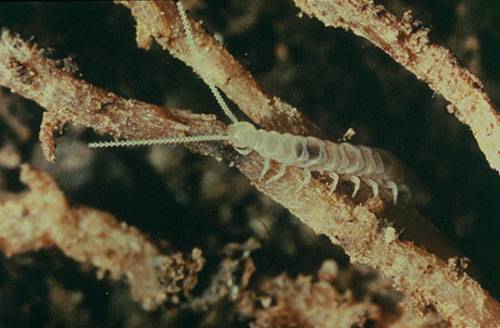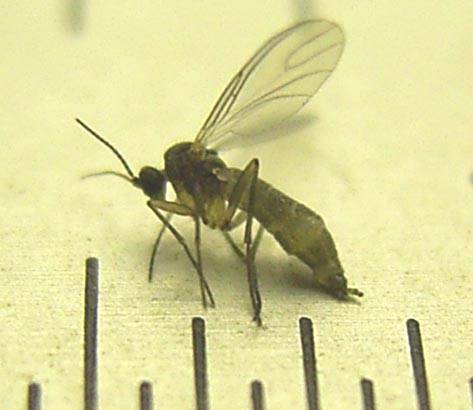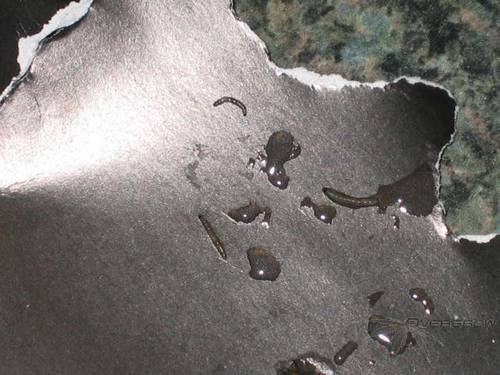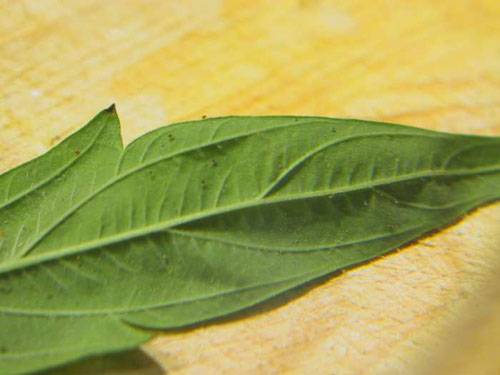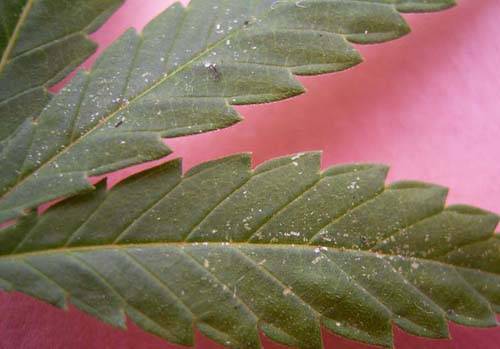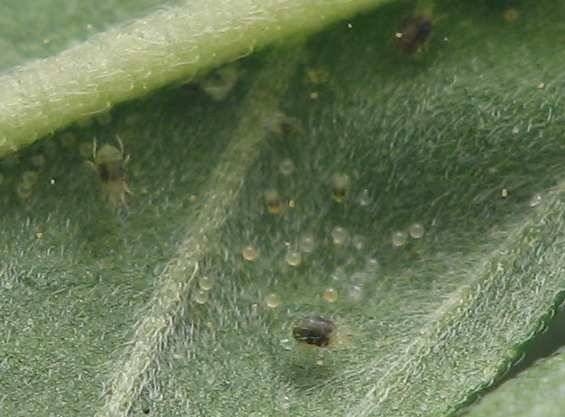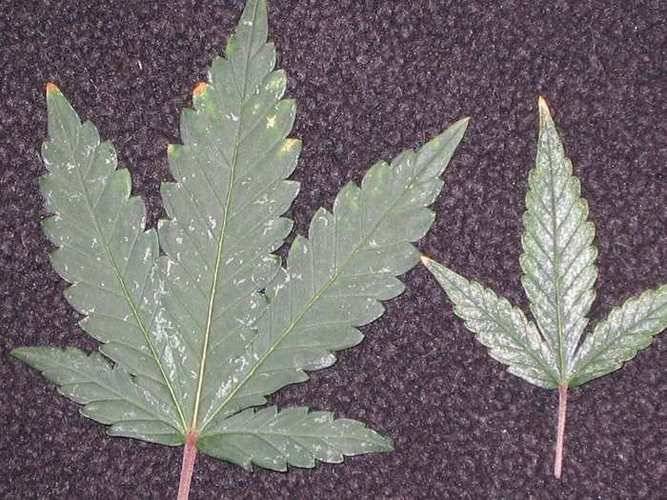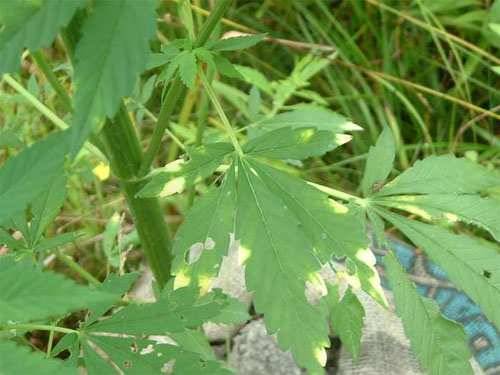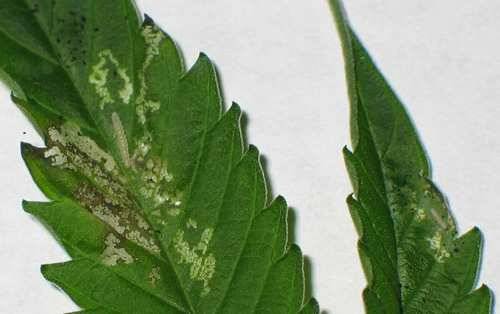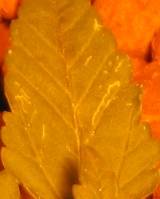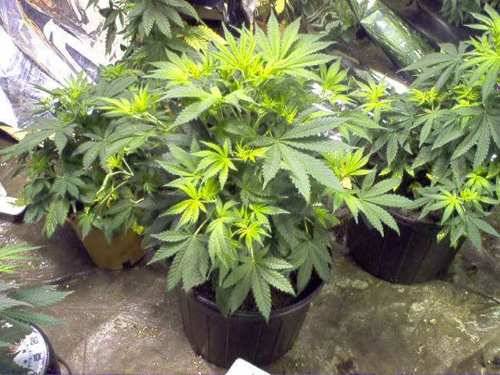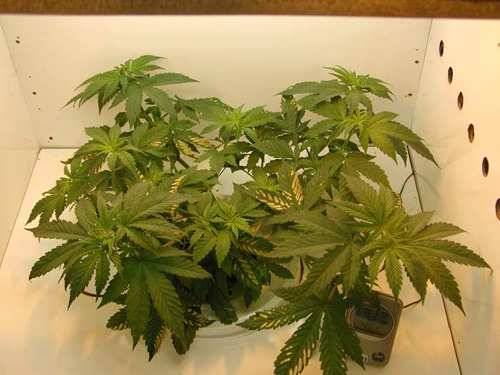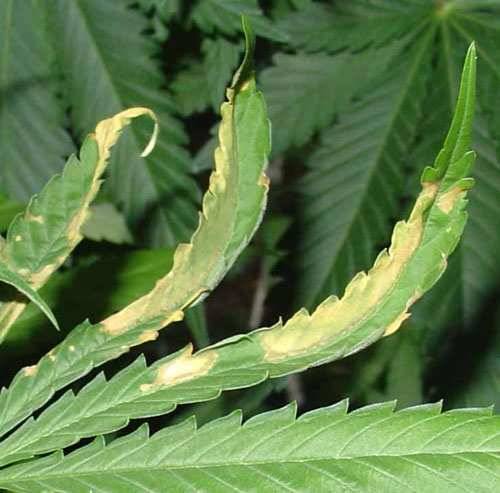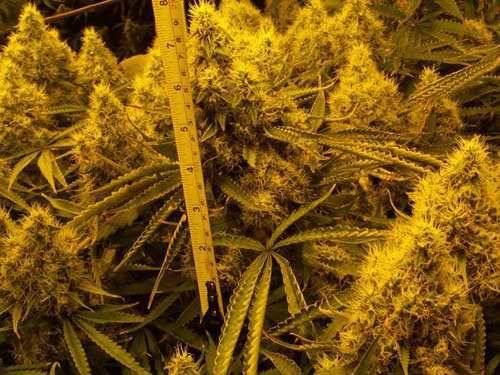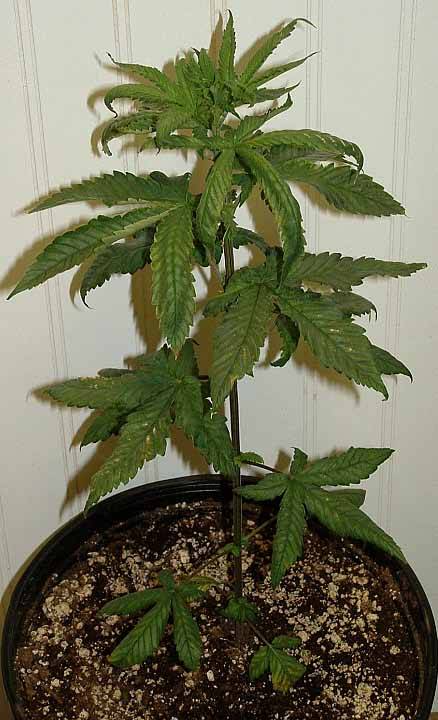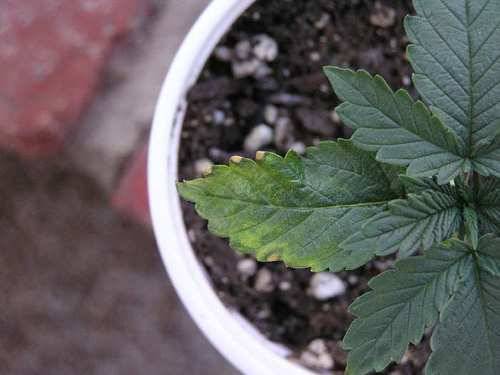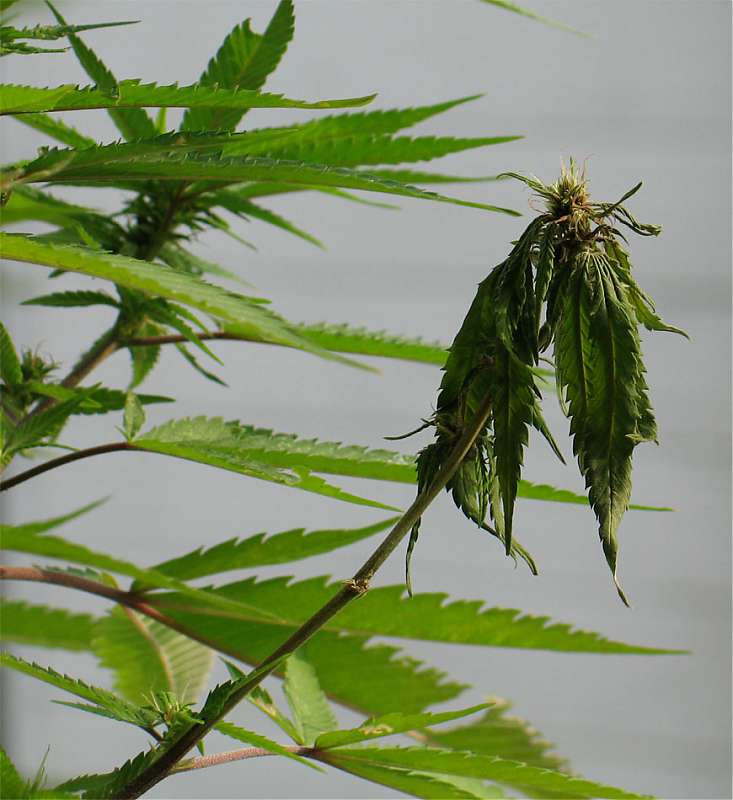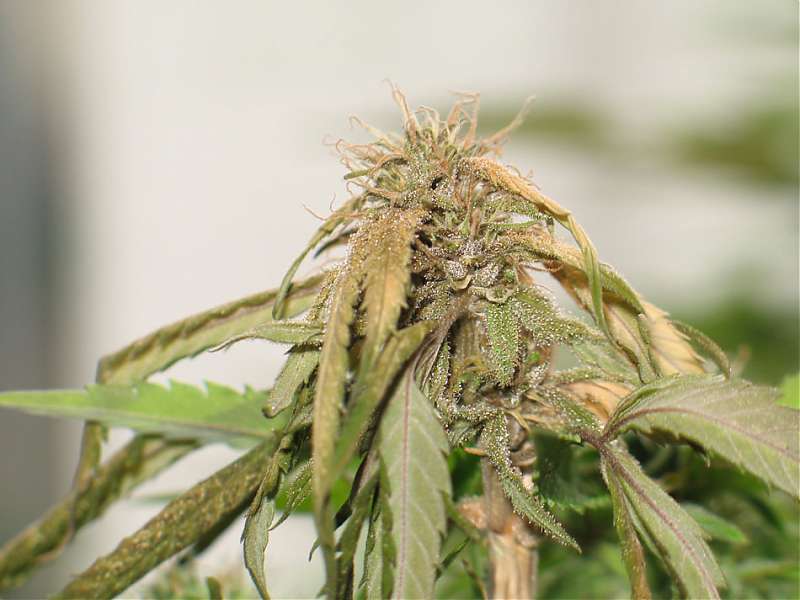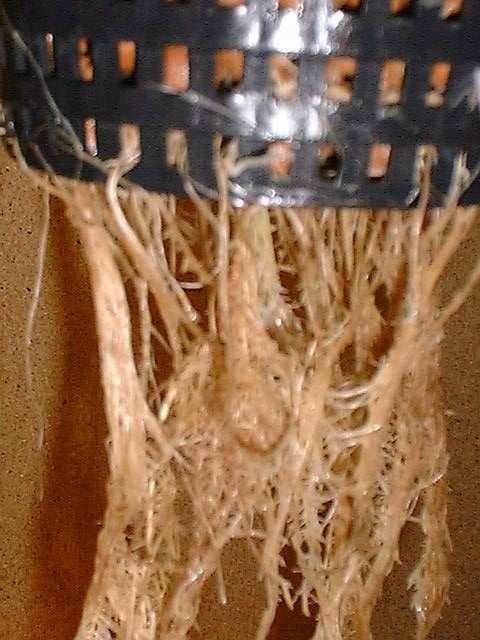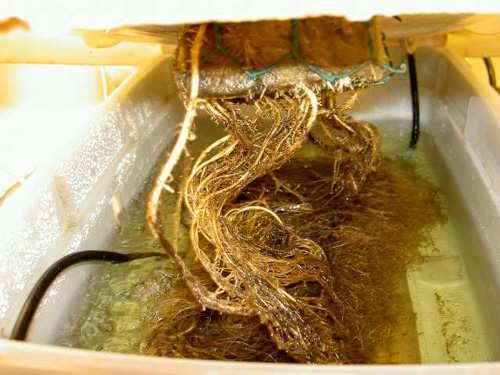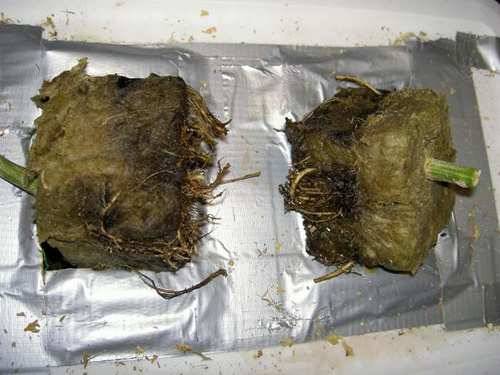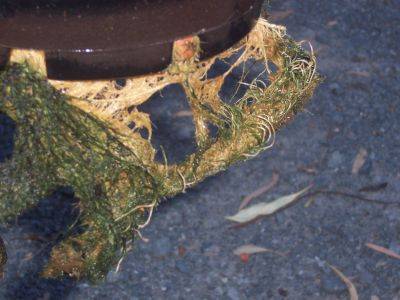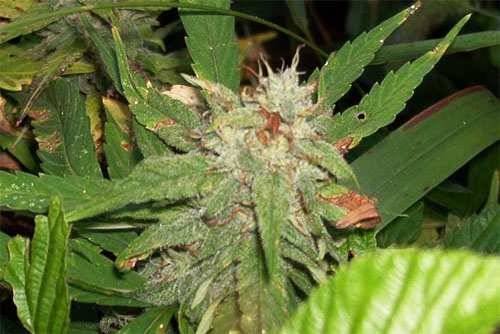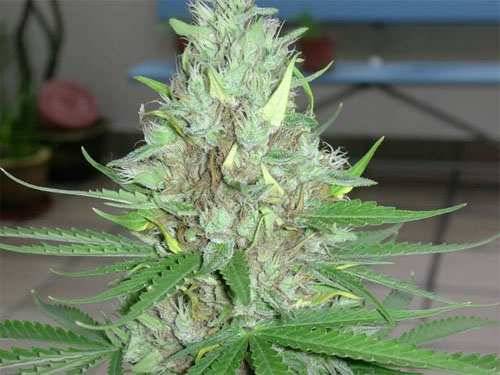I have put a lot of work into this for those who need it when I'm not around 
This thread has been updated 7/15/2010
All updates are in RED.
Scroll down to the bottom for most of the updated stuff.
If you need help please DO NOT post in this thread. Make a thread in the infirmary, or post in the link below if you need my help with something.
Split From: The Complete Gude to Sick Plants,pH and Pest Troubles
When you do post please give as much detailed information as possible to faster get your diagnosis.
Questions provided by CannaGod from PLanetGanja and 10K from ICMAG
*NOTE: Please Cut And Paste only the section that applies and add your response. The more information you can give the better and faster people can help you out.Pictures should be added to every thread to ensure a proper diagnosis, when using pictures please ensure your HPS if using one is not turned on while taking pictures, as the lighting hides the plants problems. Fill out
ARE YOU USING?
SOIL:
How long has this problem been going on?
What STRAIN are you growing?
What was the establishing technique? (seed or clone?)
What is the age of your plants?
How long have they been in the soil mixture they are in now?
Were they in the same mixture when they were seedlings/smaller plant? If not, what mixture were they in before?
How Tall are the plants?
What PHASE (seedling, vegetative or flower) are the plants in?
What Technique are you using? (SOG, SCROG etc)
What size pots are you using? (Include how many subjects to pot)
What substrate/medium are you using? What brand of soil mixture are you using?(percentage of perlite, vermiculite...etc?)
What brand Nutrient's are you using?
How much of each nutrient are you using with how much water? *Knowing the brand is very helpful*
How often are you feeding?
If flowering, when did you switch over to using Bloom nutrients?
What order are you mixing your nutrients? (example: veg nutes 1st, bloom 2nd ect)
What is the TDS/EC/PPM of your nutrients used?
What is the pH of the "RUN-OFF"?
How often are you testing pH/ppm/EC/TDS?
What method of pH test was administered? Using Strips? pH pen?
How often are you watering?
When was your last feeding and how often are you feeding?
What size bulb are you using?
How old is your bulbs?
What is the distance to the canopy?
What is your RH Factor? (Relative Humidity)
What is the canopy temperature?
What is the Day/Night Temp? (Include fluctuation range)
What is the current Air Flow? (cfm etc.)
Tell us about your ventilation, intake exhaust and when its running and not running ?
Is the fan blowing directly at plants?
Is the grow substrate constantly wet or moist?
Is your water HARD or SOFT?
What water are you using? Reverse Osmosis (RO)? Tap? Bottled? Well water? Distilled? Mineral Water?
If using tap water, what is the ppm/EC/TDS of the water right out of the tap?(Only if you have a tds pen)
If using RO,Distilled,mineral water, what is the ppm/EC/TDS without any additives?(Only if you have a tds pen)
Are you using water from a water softener?
Has plant been recently pruned, cloned or pinched?
Have any pest chemicals been used? If so what and when?
Are plant's infected with pest's?
HYDROPONICS/Aero Ponics/Coco/Soiless/
How long has this problem been going on?
Are you growing in a PVC grow tent? (example: Hydrohut or any other non brand tents)
What system are you running? (DWC? Ebb flow? Aero? Water Farm? Flood Tables? and so on...)
What STRAIN are you growing?
What was the establishing technique? (Were the seed or clone?)
What is the age of your plants?
How long have they been in there mixture they are in now?(coco,soiless etc..)
How tall are the plants?
What PHASE are the plants in? (seedling, vegetative or flower) are the plants in?
What Technique are you using?
What substrate/medium are you using?(Hydroton, RockWool etc.)
What is the Water temperature?
What color are your roots? White? Brown? Are your roots slimy?
What Nutrient's are you using?(If growing soiless)
How much of each nutrient are you using with how much water? *Knowing the brand is very helpful*
How often are you feeding? (If using soiless)
How often are you giving nutrients? (If using soiless)
If flowering, when did you switch over to using Bloom nutrients?
What order are you mixing your nutrients? (example: veg nutes 1st, bloom 2nd ect)
What is the TDS/EC/PPM you are using
What is the pH of the "Tank"?
How often are you testing your pH/PPM/EC/TDS?
Are you sure your calibration is correct on your equipment?
When was your last watering?
What is your water temps?
When was your last feeding change? (ie. grow-bloom-micro-additional)
How often do you clean your system: example: Flush out water replace with clean water and nutrients?
What size bulb are you using?
How old is the bulbs you are using?
What is the distance to the canopy?
What is your RH Factor(Relative Humidity)?
What is the canopy temperature?
What is the Day/Night Temp? (Include flucutaion range)
What is the current Air Flow? (cfm etc.)
Tell us about your ventilation, intake exhaust and when its running and not running ?
Is the fan blowing directly at plants?
Is your water HARD or SOFT?
What water are you using? Reverse Osmosis (RO)? Tap? Bottled? Well water? Distilled? Mineral Water?
If using tap water, what is the ppm/EC/TDS of the water right out of the tap?
If using RO,Distilled,mineral water, what is the ppm/EC/TDS without any additives?
Are you using water from a water softener?
Has plant been recently pruned, cloned off of or pinched
Have any pest chemicals been used? If so, What and When?
Are plant's infected with pest's
I have been doing a lot of research on sick plants and also helping out others a lot on sick plants!
Most of the stuff I have learned is from others and keeping up to date on there problems they are having. Some I have learned on my own, the sick plant troubles I have had was ph troubles! I didn’t really think the importance of how ph plays a role with your plants being healthy or dead.
I honestly think one of the most important parts of your growing is having a good solid ph tester, a digital one is the best to have. There are other ones you can buy as well, liquid ph test kits are inexpensive and get the job done if you can't afford a digital ph meter, STAY AWAY FROM SOIL TESTERS, they don't do the job and are not very accurate at all. Ph test strips work well, even if you are on a budjet! So if you rely on a soil tester and its tell you your soil is 7 and your having problems, 9 times out of 10 it's going to be your water ph that is messing up the soil ph check the water you are using. Unless you are using additives in your soil mixture like blood bone meal, and Peat moss those will throw your ph off too.
Adding nutes to your water can cause the ph to get low as well, so its best to test your ph of your water before and after you add your nutes. Nutrient deficiencys are mostly caused by human mistakes,along with to much or to little of the amount of nutrients available. The best range for nutrients to be absorbed is between a pH of 5 and 7 and a (TDS) range of 800 to 3000 PPM.
Having these conditions will help making nutrient deficiencys alot easier to overcome.
Well this guide I am making on sick plants is going to be very detail in helping out as many as possible… I have collected a lot of accurate data and have been putting it together piece by piece… Stuff on what kinda of nutrients can lead to locking out other nutrients as well….
I will be updating this until it gets done, because I have a lot of information but just not on every sick problem that is out there….
Mobile Elements are mostly going to affect the older leaves first then work its way to other leaves and then the nutrients will be taken from old leaves to newer growths…
The following are mobile elements and as well macro nutrients.
First off, we are going to start out with Nitrogen.
Nitrogen (N) Mobile Element and Macro Element
Benefit: Nitrogen plays a very big role in your plants; this one element is directly responsible for production of chlorophyll, photosynthesis, Amino Acids, which are the building block of Proteins. The myriad of enzymes which help the plants growth in leaves stems and the how well the vigor of your plants is.
Nitrogen is the biggest mobile element meaning it can travel anywhere on the plant.
Usually the def will start on the lower to middle part of the plant, and then will usually happen to older leaves first. Then the deficiency will work its way up the plant. Your plant can be green on top, then yellowing on the lower leaves when the deficiency is starting out. Yield will be greatly reduced without good amounts of nitrogen in your plants. Sometimes in bad cases the leaves will turn a purplish color along with the yellowing.
Unlike a magnesium deficiency, nitrogen def will start from the tips and work its way back to the leaf node. Nitrogen and Magnesium get confused. The best way to tell them apart is, nitrogen deficiency starts around the tips and works its way to the back of the leaves, where a magnesium deficiency will cover the entire outer part of the leave and make the entire leaves yellow leaving the veins to stay green. If your plants are having a slow growth rate and have yellowing of the leaves, then most likely it’s a nitrogen deficiency.
Towards the middle to end of flowering stages, the plant will show a nitrogen deficiency almost always. This process is completely normal and just let the plant naturally yellow out as it uses it's stored nutrients. This actually helps you by getting ready for final flushing and then harvesting. At this point DO NOT not use nitrogen to fix the problem. The yellowing leaves will then eventually drop off after the plant is done with them.
Parts affected by a nitrogen deficiency are: Older foliage, going to whole plant, Petioles (rare) cases.
Now for having too much nitrogen in your growing mediums or soil. The plant will have like an overall DARK green look and have delayed maturity. Due to Nitrogen being involved in vegetative growth, to much nitrogen will result in tall plants with weak stems. New growth will be very lively and plant transpiration will be high, but not always. Nitrogen toxicity can be seen when there are very very dry conditions almost as if there was a drought, which may show a burning effect. If you give your plants ammonium based nutrients they may show NH4+ toxicity, which will show a smaller plant growth and lesions that occur on stems and roots, leaf margins that will roll downward. Also the big fan leaves will have “the claw” look. The tips will point down but the leaves will stay up as if when you bend your fingers downwards. Leaves can be twisted when growing… mainly new growths. Roots will be under developed along with the slowing of flowering. Yields will be decreased, because to much nitrogen in early stages of flowering slows down bud growth. Water uptake is slowing down from the vascular breakdown of the plants as well. Too much potassium and nitrogen will lock out calcium as well.
Problems with Nitrogen being locked out by PH troubles.
Waterlogged soil and Soil with low organic matter.
Nitrogen is a very important element in the plant, all of them are but some are more important than others. For soil the best ph to have is 6.8. Why? Because at 6.8, that’s the best number for ALL available nutrients to be absorbed into the plant without any of them being locked out. For hydro and soil less mediums best ph to have is around 5.8.
Try not to keep your plants to cold, because the cold temps will cause the nitrogen harder for the plant to be absorbed.
PH levels for Nitrogen:
Soil levels
Nitrogen gets locked out of soil growing at ph levels of 4.0- 5.5.
Nitrogen is absorbed best in soil at a ph level of 6.0-8.0. ( wouldn’t recommend having a ph of over 7.0 in soil) best range to have nitrogen is a ph of 6-7. Anything out of that range will contribute to a nitrogen def.
Hydro and Soil less Mediums
Nitrogen gets locked out of Hydro, Soil less mediums at the levels of 4.5-5.0.
Nitrogen has the best absorption rate at a ph of 5.5 to 8.0
(Wouldn’t recommend having a ph over 6.5 in hydro and soil less mediums.) Best range to have Nitrogen is: 5.0-7.0. Anything out of that range will contribute to a nitrogen def.
Solution to fixing a Nitrogen deficiency
Avoid excessive ammonium nitrogen, which can interfere with other nutrients. Too much N delays flowering. Plants should be allowed to become N-deficient late in flowering for best flavor.
A goof solid N-P-K ratio will fix any nitrogen deficiency. Any chemical or organic fertilizers that have Nitrogen in them will fix a nitrogen deficiency., Peters all purpose plant food 20-20-20 is good, Miracle grow All purpose plant food, Miracle grow Tomato plant food, (Only mixing at ½ strength when using chemical nutrients, or it will cause nutrient burn!) as well and blood meal! If you need to give your plants a quick solution to nitrogen and you want to use blood meal, I suggest making it into a tea for faster use, where blood meal is slow acting, but when made into a tea it works quicker! Other sources of nitrogen are dried blood, Cotton seed meal which is slow acting, Insect eating bat guano which is fast acting. Bone meal which is a gradual absorption when not made into a tea.( also excellent source of phosphorus). Fish Meal Or Fish Emulsion is a good source of nitrogen and is medium acting. Worm castings, which is gradual absorption. Seabird guano, All purpose Millennia Seabird guano, Orginal Seabird guano All Purpose, Crabshell ,which is slow absorption. Fox Farm Grow Big, which is fast acting. ( can bring down your ph as well)
Here are a list of things that help fix a Nitrogen Deficiency:
Chemical Nutrients
Advanced nutrients Grow (2-1-6)
Vita Grow (4-0-0),
BC Grow(1.2-3.2-6.5)
GH Flora Grow (2-1-6)
GH Maxi grow (10-5-14)
GH floraNova grow (7-4-10),
Dyna gro Grow (7-9-5)
Organic Nutrients
Dr. Hornby's Iguana Juice Grow (3-1-3)
Advanced Nutrients Mother Earth Grow (1.5-.75-1.5)
Earthjuice Grow (2-1-1),
Pure Blend Pro (3-1.5-4)
Bone Meal(0-10-0)
Blood Meal(12-0-0)
Fish Emulsion (5-1-1)
Seabird Guano (11-13-3)
Crab Shells(2.5-3.0-.5)
Pure Blend Grow (0.4-.01-.5)
Marine Cuisine (10-7-7)
MaxiCrop Seaweed (1-0-3)
Super Tea (5-5-1)
Mexican Bat Guano (10-2-0)
Sea Island Jamaican Bat Guano (1-10-0)
Kelp Meal (1-0-2)
Seaweed Plus Iron
Neptune's Harvest (2-4-0.5)
Alaska Start-Up(2-1-2)
Bio-Grow (1.8-0.1-6.6)
Age old Grow (12-6-6)
AGE Old Kelp (.30-.25-.15)
Neptune's Harvest (2-4-1)
Maxicrop Seweed(.1-0-1)
METANATURALS Organic grow (3-3-3)
METANATURALS Organic nitrogen (16-0-0)
So adding anyone of these above should fix up your nitrogen deficiency! Nitrogen deficient plants usually recover in about a week, affected leaves will not recover.
Now if you added to much chemical nutrients and or organics, (which is hard to burn your plants when using organics) you need to flush the soil with plain water. You need to use 2 times as much water as the size of the pot, for example: If you have a 5 gallon pot and need to flush it, you need to use 10 gallons of water to rinse out the soil good enough to get rid of excessive nutrients. Soluble nitrogen (especially nitrate) is the form that's the most quickly available to the roots, while insoluble N (like urea) first needs to be broken down by microbes in the soil before the roots can absorb it.
Note: Blood Meal, Dried Blood, Guanos, Kelp Meal, Cotton Seed Meal, Peat Moss, Sulfur and fish meal are all acidic and can bring your ph down, so if you add these please monitor your ph when using those.
Note: Bone Meal, Rock Phosphate, Wood Ashes pretty much all ashes, Shellfish Compost and Crab Meal are all alkaline and can make your ph go up, so if you add any of these please monitor your ph.
Here are 3 pics of what a nitrogen def looks like.... the first one is a nitrogen deficiency in vegging. the 2nd picture is nitrogen def in flowering; THis is completely normal for mid to late flowering; as you would want your plant to naturally yellow at the end. DO NOT add nitrogen supplement to fix the problem; just let the plant yellow as cannabis does towards the end of flowering. The last picture is one that is caused by TO MUCH Nitrogen.
(Picture 1 is a Nitrogen Deficiency in veg)( Thanks to m&m for letting me use the pic)
(Picture 3 is Mine)
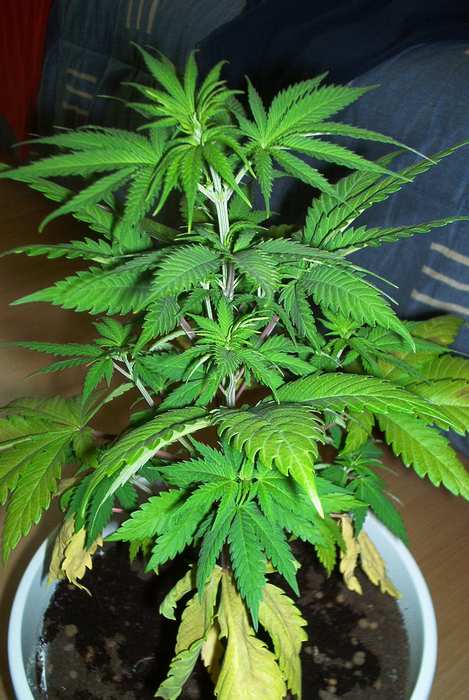
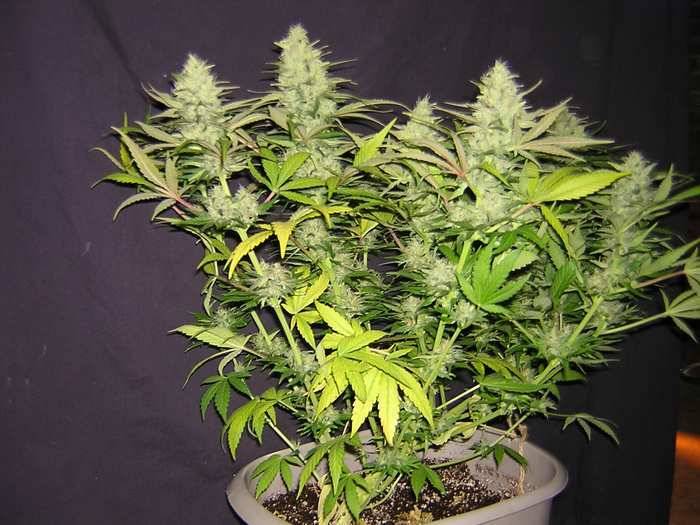
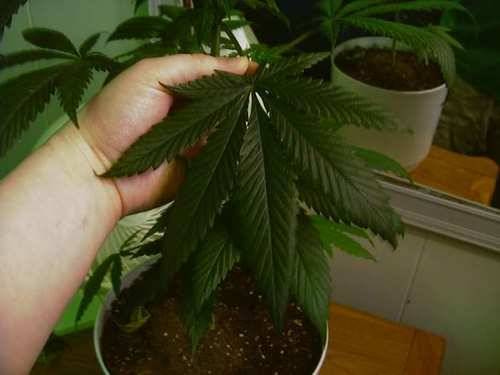
Picture 4 shows nitrogen deficiency, caused by ONLY overwatering, in order to fix this; you must stop watering so heavily/frequently.
(Photo Credit: Trichome Design)
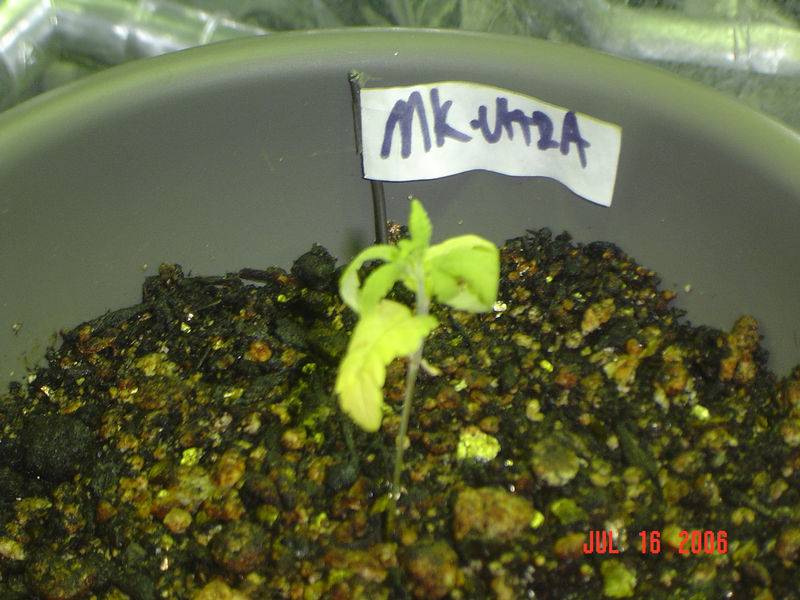
Phosphorus (P) Mobile Element and Macro Element
Benefit: Phosphorus does a lot of things for the plant. One of the most important parts of Phosphorus is: It aids in root growth and influences the vigor of the plant and is
one of the most important elements in flowering as well helps to germinate seedlings.
Phosphorus is an essential plant nutrient, and since it is needed in large amounts, it is classified as a macronutrient. Phosphorus is a MAJOR important nutrient in the plants reproductive stages. Without this element the plants will have a lot of problems blooming without proper levels of Phosphorus.
When your plants are deficient in phosphorus, this can overall reduce the size of your plants. Not enough causes slow growth and causes the plant to become weak, to little amount of Phosphorus causes slow growths in leaves that may or may not drop off. The edges all around the leaves or half of the leaves can be brownish and work its way inwards a bit causing the part of the leaves to curl up in the air a bit. Fan leaves will show dark greenish/purplish and yellowish tones along with a dullish blue color to them. Sometimes the stems can be red, along with red petioles that can happen when having a Phosphorus deficiency. This isn’t a sure sure sign of you having one though, but can be a sign. Some strains just show the red petioles and stems from its genes.
So pretty much the overall dark green color with a purple, red, or blue tint to the fan leaves is a good sign of a Phosphorus deficiency. Having Cold weather (below 50F/10C) can make phosphorous absorption very troublesome for plants.
Many people get a Phosphorus deficiency confused with a fungus problem because the ends of the leaves look like a fungus problem, But the damage occurs at the end of the leaves. side of the leaves and has a glass like feeling to it as if it had a ph problem. Parts affected by a phosphorus deficiency are: Older Leaves, Whole plant, Petioles.
Too much Phosphorus levels affect plant growth by suppressing the uptake of: Iron, potassium and Zinc, potentially causing deficiency symptoms of these nutrients to occur def in plants. A Zinc deficiency is most common under excessive phosphorus conditions,
As well as causing other nutrients to have absorption troubles like zinc and copper. Phosphorus fluctuates when concentrated and combined with calcium
Problems with Phosphorus being locked out by PH troubles
Cold wet soils, acid or very alkaline soils, compacted soil.
Soil
Phosphorus gets locked out of soil growing at ph levels of 4.0-5.5
Phosphorus is absorbed best in soil at a ph level of 6.0-7.5 (wouldn’t recommend having a ph of over 7.0 in soil) Anything out of the ranges listed will contribute to a Phosphorus deficiency.
Hydro and Soil less Mediums
Phosphorus gets locked out of Hydro and Soil less Mediums at ph levels of 6.0-8.5.
Phosphorus is absorbed best in Hydro and Soil less Mediums at ph levels of 4.0- 5.8. (Wouldn’t recommend having a ph over 6.5 in hydro and soil less mediums.) Best range for hydro and soil less mediums is 5.0 to 6.0. Anything out of the ranges listed will contribute to a Phosphorus Deficiency.
Solution to fixing a Phosphorus deficiency
Some deficiency during flowering is normal, but too much shouldn't be tolerated. Any chemical or organic fertilizers that have Phosphorus in them will fix a Phosphorus deficiency. If you have a phosphorus deficiency you should use any N-P-K ratio that is over 5.Again Peters all purpose 20-20-20 is a good mix. Miracle grow Tomato plant food, Miracle grow All purpose plant food (Only mixing at ½ strength when using chemical nutrients, or it will cause nutrient burn!) Other forms of phosphorus supplements are: Bone meal, which is gradual absorption, I suggest making it into a tea for faster use, where bone/blood meal is slow acting, but when made into a tea it works quicker! Fruit eating bat guano, which is fast absorption, Worm castings, which is gradual absorption, Fish meal, which is medium absorption, Soft Rock Phosphate, which is medium absorption, Jamaican or Indonesian Guano, which is fast absorption. Crabshell, which is slow absorption. Tiger Bloom , which is fast absorption.
Here is a list of things to help fix a Phosphrus Deficiency.
Chemical
Advanced nutrients Bloom (0-5-4)
Vita Bloom (0-7-5)
BC Bloom (1.1-4.4-7)
GH Flora Bloom (0-5-4)
GH Maxi Bloom (5-15-14)
GH Floranova Bloom (4-8-7)
Dyna-Gro Bloom (3-12-6)
Fox Farm Tiger Bloom (2-8-4)
Awsome Blossums
Organic
Dr. Hornby's Iguana Juice Bloom (4-3-6)
Advanced Nutrients Mother Earth Bloom (.5-1.5-2)
Fox Farm Big Bloom (.01-.3-.7)
Earth Juice Bloom (0-3-1)
Pure Blend Bloom (2.5-2-5)
Pure Blend Pro Bloom (2.5-2-5)
Buddswell (0-7-0)
Sea Island Jamaican Bat Guano (1-10-0)
Indonesian Bat Guano (0-13-0)
Rainbow Mix Bloom (1-9-2)
Earth Juice Bloom (0-3-1)
BIO BLOOM (2-6-3.5)
AGE OLD BLOOM (5-10-5)
ALASKA MORBLOOM (0-10-10)
METANATURALS ORGANIC BLOOM (1-5-5)
Any of these will cure your phosphorus deficiency. Affected leaves will not show recovery but new growth will appear normal.
Now if you added to much chemical ferts and or organics,( which is hard to burn your plants when using organics) You need to Flush the soil with plain water. You need to use 2 times as much water as the size of the pot, for example: If you have a 5 gallon pot and need to flush it, you need to use 10 gallons of water to rinse out the soil good enough to get rid of excessive nutrients.
Note: Blood Meal, Dried Blood, Guanos, Kelp Meal, Cotton Seed Meal, Peat Moss,
Sulfur and fish meal are all acidic and can bring your ph down, so if you add these please monitor your ph when using those.
Note: Bone Meal, Rock Phosphate, Wood Ashes pretty much all ashes, Shellfish Compost and Crab Meal are all alkaline and can make your ph go up, so if you add any of these please monitor your ph.
Picture 1 is a Phosphorus deficiency during vegetative growth.
Picture 2 is what a phosphorus deficiency looks like in flowering.
Picture 3 shows phosphorus being locked out due to cold temps for the seedling
(Picture 1 is Mine)
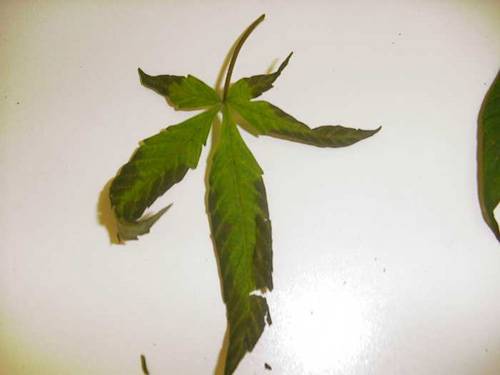
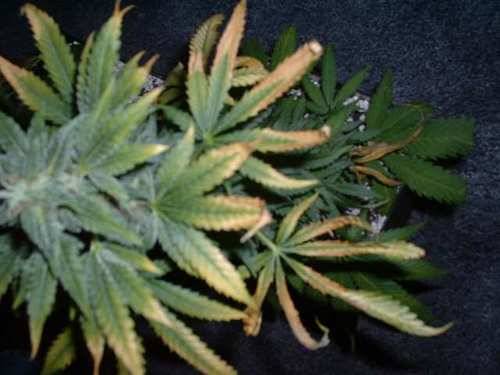
Photo Credit:TikTok420
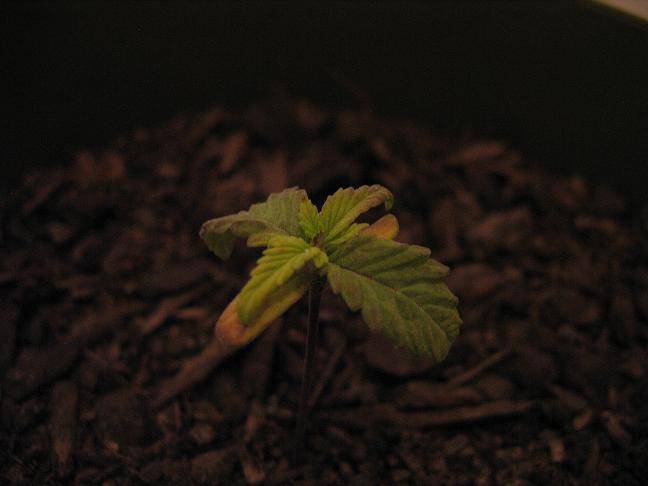
Picture of Phosphorus being locked out from cooler temps.
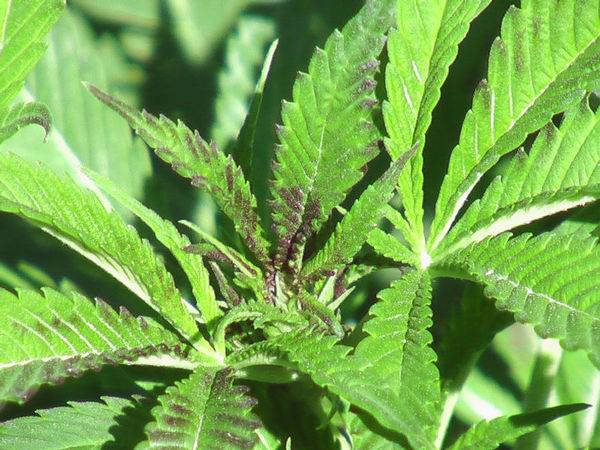
Potassium (K) Mobile Element and Macro Element
Potassium plays a big role as well. Having good amounts of potassium in your plants helps in having sturdy and thick stems, disease-resistance, water respiration, as well aids in photosynthesis. Potassium is also found in the whole plant. It is necessary for all activities having to do with water transportation. Potassium is necessary for all stages of growth, especially important in the development of Buds.
Having to little of Potassium in your plants causes the plants leaves to show retarded growth and show a scorched tip and edges around the leaves. Plants may stretch and your branches can be easily broken or weak. Don’t get this deficiency confused with iron, because it almost acts like iron but to tell the difference in the two is: for potassium the tips of the leaves curl and the edges burn and die. Older leaves may show a red color and leaves could curl upwards. Dead patches (Necrosis) can happen on the margins of larger fan leaves thus, the leaves will eventually die off and turn brown. The Older leaves will show different patches of color (mottle) and turn yellow between the veins, following by whole leaves that turn dark yellow and die. The plants overall growth slows down, mostly when they are in vegetative stage. To little amount of potassium also slows the growth of buds during flowering stages. Dark edges will appear around the edges of the leaf when the deficiency is starting to happen. When your Relative humidity is low, you can almost bet your going to soon get a potassium deficiency from your plants perspiration.
Potassium can get poorly absorbed when having too much Calcium or ammonium nitrogen, and maybe cold weather. Having to much sodium (Na) causes potassium to be displaced. SO keep those in mind… Parts affected by a Potassium Deficiency are: older leaves and leaf margins.
When you have too much Potassium in your soil, it can lead to big troubles, like salt damage and acid fixation of the root system, as well as too much potassium can cause a calcium deficiency. Your fan leaves will show like a light to a dark yellow to whitish color in between the veins. Due to a molecular imbalance, potassium toxicity can cause a reduced uptake and lead to the deficiencies of Mg, and in some cases, Ca. Also leads to the other nutrients to not be absorbed properly leading to lots of other deficiency such as: magnesium, manganese, zinc and iron and can cause problems with calcium as well.
Problems with Potassium being locked out by PH troubles
Soils with excessive Leeching and High ph soils and or water.Soils that are potassium fixated. An excess of kitchen salts (sodium) in the root system/enviroment.
Soil
Potassium gets locked out of soil growing at ph levels of 4.0-5.5
Potassium is absorbed best in soil at a ph level of 6.0-9.5. (Wouldn’t recommend having a ph of over 7.0 in soil) anything out of the ranges listed will contribute to a Potassium deficiency.
Hydro and Soil less Mediums
Potassium gets locked out of Hydro and Soil less Mediums at ph levels of 4.0-4.5, 6.0-6.5.
Potassium is absorbed best in Hydro and Soil less Mediums at ph levels of 4.7-5.3, 6.7-8.5. (Wouldn’t recommend having a ph over 6.5 in hydro and soil less mediums.) Best range for hydro and soil less mediums is 5.0 to 6.0. Anything out of the ranges listed will contribute to a potassium deficiency.
Solution to fixing a Potassium deficiency
Any Chemical/Organic nutrients that have potassium in them will fix a potassium deficiency. Again Peters All Purpose plant food 20-20-20, will cure the potassium deficiency , Miracle grow Tomato plant food, Miracle grow All purpose plant food.( Only mixing at ½ strength when using chemical nutrients, or it will cause nutrient burn!) Some other supplements of potassium are: Wood ashes, which are fast absorption, Kelp Meal, which is medium absorption, Greensand, which is slow absorption, granite dust, which is slow absorption. Sulfate of Potash, Sulfate of Potash Magnesia, Muriate of Potash, which are medium absorption. FOXFARM GROW BIG HYDROPONIC CONCENTRATE, which is fast absorption. (FFGB can bring your ph down as well) Earth Juice Meta-K, which is fast acting. (Can bring down your ph as well) Leaves will never recover, but the plant will show recovery after about 4 to 5 days when using a fast acting nutrient.
Note: Wood Ashes, can make your ph go up a bit, so please monitor your ph when using it.
Now if you added to much chemical nutrients and or organics, (which is hard to burn your plants when using organics) you need to flush the soil with plain water. You need to use 2 times as much water as the size of the pot, for example: If you have a 5 gallon pot and need to flush it, you need to use 10 gallons of water to rinse out the soil good enough to get rid of excessive nutrients.
Picture 1 and 2 shows a Potassium deficiency ( Thank You General Ganja for letting me use Picture 1!)
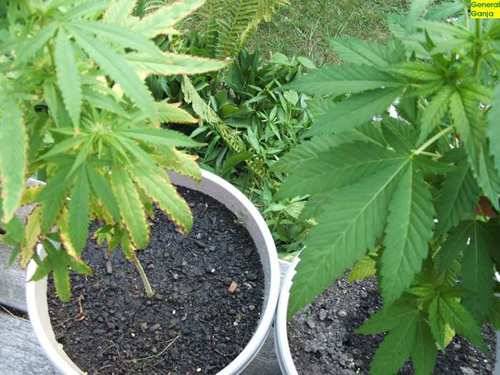
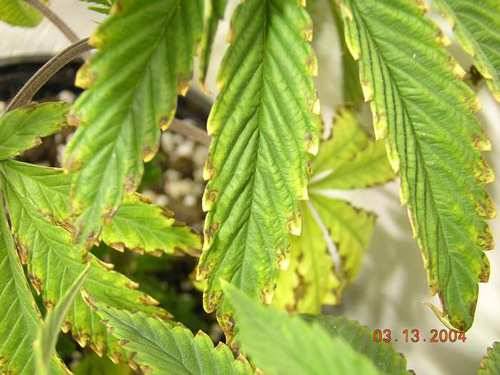
This thread has been updated 7/15/2010
All updates are in RED.
Scroll down to the bottom for most of the updated stuff.
If you need help please DO NOT post in this thread. Make a thread in the infirmary, or post in the link below if you need my help with something.
Split From: The Complete Gude to Sick Plants,pH and Pest Troubles
When you do post please give as much detailed information as possible to faster get your diagnosis.
Questions provided by CannaGod from PLanetGanja and 10K from ICMAG
*NOTE: Please Cut And Paste only the section that applies and add your response. The more information you can give the better and faster people can help you out.Pictures should be added to every thread to ensure a proper diagnosis, when using pictures please ensure your HPS if using one is not turned on while taking pictures, as the lighting hides the plants problems. Fill out
ARE YOU USING?
SOIL:
How long has this problem been going on?
What STRAIN are you growing?
What was the establishing technique? (seed or clone?)
What is the age of your plants?
How long have they been in the soil mixture they are in now?
Were they in the same mixture when they were seedlings/smaller plant? If not, what mixture were they in before?
How Tall are the plants?
What PHASE (seedling, vegetative or flower) are the plants in?
What Technique are you using? (SOG, SCROG etc)
What size pots are you using? (Include how many subjects to pot)
What substrate/medium are you using? What brand of soil mixture are you using?(percentage of perlite, vermiculite...etc?)
What brand Nutrient's are you using?
How much of each nutrient are you using with how much water? *Knowing the brand is very helpful*
How often are you feeding?
If flowering, when did you switch over to using Bloom nutrients?
What order are you mixing your nutrients? (example: veg nutes 1st, bloom 2nd ect)
What is the TDS/EC/PPM of your nutrients used?
What is the pH of the "RUN-OFF"?
How often are you testing pH/ppm/EC/TDS?
What method of pH test was administered? Using Strips? pH pen?
How often are you watering?
When was your last feeding and how often are you feeding?
What size bulb are you using?
How old is your bulbs?
What is the distance to the canopy?
What is your RH Factor? (Relative Humidity)
What is the canopy temperature?
What is the Day/Night Temp? (Include fluctuation range)
What is the current Air Flow? (cfm etc.)
Tell us about your ventilation, intake exhaust and when its running and not running ?
Is the fan blowing directly at plants?
Is the grow substrate constantly wet or moist?
Is your water HARD or SOFT?
What water are you using? Reverse Osmosis (RO)? Tap? Bottled? Well water? Distilled? Mineral Water?
If using tap water, what is the ppm/EC/TDS of the water right out of the tap?(Only if you have a tds pen)
If using RO,Distilled,mineral water, what is the ppm/EC/TDS without any additives?(Only if you have a tds pen)
Are you using water from a water softener?
Has plant been recently pruned, cloned or pinched?
Have any pest chemicals been used? If so what and when?
Are plant's infected with pest's?
HYDROPONICS/Aero Ponics/Coco/Soiless/
How long has this problem been going on?
Are you growing in a PVC grow tent? (example: Hydrohut or any other non brand tents)
What system are you running? (DWC? Ebb flow? Aero? Water Farm? Flood Tables? and so on...)
What STRAIN are you growing?
What was the establishing technique? (Were the seed or clone?)
What is the age of your plants?
How long have they been in there mixture they are in now?(coco,soiless etc..)
How tall are the plants?
What PHASE are the plants in? (seedling, vegetative or flower) are the plants in?
What Technique are you using?
What substrate/medium are you using?(Hydroton, RockWool etc.)
What is the Water temperature?
What color are your roots? White? Brown? Are your roots slimy?
What Nutrient's are you using?(If growing soiless)
How much of each nutrient are you using with how much water? *Knowing the brand is very helpful*
How often are you feeding? (If using soiless)
How often are you giving nutrients? (If using soiless)
If flowering, when did you switch over to using Bloom nutrients?
What order are you mixing your nutrients? (example: veg nutes 1st, bloom 2nd ect)
What is the TDS/EC/PPM you are using
What is the pH of the "Tank"?
How often are you testing your pH/PPM/EC/TDS?
Are you sure your calibration is correct on your equipment?
When was your last watering?
What is your water temps?
When was your last feeding change? (ie. grow-bloom-micro-additional)
How often do you clean your system: example: Flush out water replace with clean water and nutrients?
What size bulb are you using?
How old is the bulbs you are using?
What is the distance to the canopy?
What is your RH Factor(Relative Humidity)?
What is the canopy temperature?
What is the Day/Night Temp? (Include flucutaion range)
What is the current Air Flow? (cfm etc.)
Tell us about your ventilation, intake exhaust and when its running and not running ?
Is the fan blowing directly at plants?
Is your water HARD or SOFT?
What water are you using? Reverse Osmosis (RO)? Tap? Bottled? Well water? Distilled? Mineral Water?
If using tap water, what is the ppm/EC/TDS of the water right out of the tap?
If using RO,Distilled,mineral water, what is the ppm/EC/TDS without any additives?
Are you using water from a water softener?
Has plant been recently pruned, cloned off of or pinched
Have any pest chemicals been used? If so, What and When?
Are plant's infected with pest's
I have been doing a lot of research on sick plants and also helping out others a lot on sick plants!
Most of the stuff I have learned is from others and keeping up to date on there problems they are having. Some I have learned on my own, the sick plant troubles I have had was ph troubles! I didn’t really think the importance of how ph plays a role with your plants being healthy or dead.
I honestly think one of the most important parts of your growing is having a good solid ph tester, a digital one is the best to have. There are other ones you can buy as well, liquid ph test kits are inexpensive and get the job done if you can't afford a digital ph meter, STAY AWAY FROM SOIL TESTERS, they don't do the job and are not very accurate at all. Ph test strips work well, even if you are on a budjet! So if you rely on a soil tester and its tell you your soil is 7 and your having problems, 9 times out of 10 it's going to be your water ph that is messing up the soil ph check the water you are using. Unless you are using additives in your soil mixture like blood bone meal, and Peat moss those will throw your ph off too.
Adding nutes to your water can cause the ph to get low as well, so its best to test your ph of your water before and after you add your nutes. Nutrient deficiencys are mostly caused by human mistakes,along with to much or to little of the amount of nutrients available. The best range for nutrients to be absorbed is between a pH of 5 and 7 and a (TDS) range of 800 to 3000 PPM.
Having these conditions will help making nutrient deficiencys alot easier to overcome.
Well this guide I am making on sick plants is going to be very detail in helping out as many as possible… I have collected a lot of accurate data and have been putting it together piece by piece… Stuff on what kinda of nutrients can lead to locking out other nutrients as well….
I will be updating this until it gets done, because I have a lot of information but just not on every sick problem that is out there….
Mobile Elements are mostly going to affect the older leaves first then work its way to other leaves and then the nutrients will be taken from old leaves to newer growths…
The following are mobile elements and as well macro nutrients.
First off, we are going to start out with Nitrogen.
Nitrogen (N) Mobile Element and Macro Element
Benefit: Nitrogen plays a very big role in your plants; this one element is directly responsible for production of chlorophyll, photosynthesis, Amino Acids, which are the building block of Proteins. The myriad of enzymes which help the plants growth in leaves stems and the how well the vigor of your plants is.
Nitrogen is the biggest mobile element meaning it can travel anywhere on the plant.
Usually the def will start on the lower to middle part of the plant, and then will usually happen to older leaves first. Then the deficiency will work its way up the plant. Your plant can be green on top, then yellowing on the lower leaves when the deficiency is starting out. Yield will be greatly reduced without good amounts of nitrogen in your plants. Sometimes in bad cases the leaves will turn a purplish color along with the yellowing.
Unlike a magnesium deficiency, nitrogen def will start from the tips and work its way back to the leaf node. Nitrogen and Magnesium get confused. The best way to tell them apart is, nitrogen deficiency starts around the tips and works its way to the back of the leaves, where a magnesium deficiency will cover the entire outer part of the leave and make the entire leaves yellow leaving the veins to stay green. If your plants are having a slow growth rate and have yellowing of the leaves, then most likely it’s a nitrogen deficiency.
Towards the middle to end of flowering stages, the plant will show a nitrogen deficiency almost always. This process is completely normal and just let the plant naturally yellow out as it uses it's stored nutrients. This actually helps you by getting ready for final flushing and then harvesting. At this point DO NOT not use nitrogen to fix the problem. The yellowing leaves will then eventually drop off after the plant is done with them.
Parts affected by a nitrogen deficiency are: Older foliage, going to whole plant, Petioles (rare) cases.
Now for having too much nitrogen in your growing mediums or soil. The plant will have like an overall DARK green look and have delayed maturity. Due to Nitrogen being involved in vegetative growth, to much nitrogen will result in tall plants with weak stems. New growth will be very lively and plant transpiration will be high, but not always. Nitrogen toxicity can be seen when there are very very dry conditions almost as if there was a drought, which may show a burning effect. If you give your plants ammonium based nutrients they may show NH4+ toxicity, which will show a smaller plant growth and lesions that occur on stems and roots, leaf margins that will roll downward. Also the big fan leaves will have “the claw” look. The tips will point down but the leaves will stay up as if when you bend your fingers downwards. Leaves can be twisted when growing… mainly new growths. Roots will be under developed along with the slowing of flowering. Yields will be decreased, because to much nitrogen in early stages of flowering slows down bud growth. Water uptake is slowing down from the vascular breakdown of the plants as well. Too much potassium and nitrogen will lock out calcium as well.
Problems with Nitrogen being locked out by PH troubles.
Waterlogged soil and Soil with low organic matter.
Nitrogen is a very important element in the plant, all of them are but some are more important than others. For soil the best ph to have is 6.8. Why? Because at 6.8, that’s the best number for ALL available nutrients to be absorbed into the plant without any of them being locked out. For hydro and soil less mediums best ph to have is around 5.8.
Try not to keep your plants to cold, because the cold temps will cause the nitrogen harder for the plant to be absorbed.
PH levels for Nitrogen:
Soil levels
Nitrogen gets locked out of soil growing at ph levels of 4.0- 5.5.
Nitrogen is absorbed best in soil at a ph level of 6.0-8.0. ( wouldn’t recommend having a ph of over 7.0 in soil) best range to have nitrogen is a ph of 6-7. Anything out of that range will contribute to a nitrogen def.
Hydro and Soil less Mediums
Nitrogen gets locked out of Hydro, Soil less mediums at the levels of 4.5-5.0.
Nitrogen has the best absorption rate at a ph of 5.5 to 8.0
(Wouldn’t recommend having a ph over 6.5 in hydro and soil less mediums.) Best range to have Nitrogen is: 5.0-7.0. Anything out of that range will contribute to a nitrogen def.
Solution to fixing a Nitrogen deficiency
Avoid excessive ammonium nitrogen, which can interfere with other nutrients. Too much N delays flowering. Plants should be allowed to become N-deficient late in flowering for best flavor.
A goof solid N-P-K ratio will fix any nitrogen deficiency. Any chemical or organic fertilizers that have Nitrogen in them will fix a nitrogen deficiency., Peters all purpose plant food 20-20-20 is good, Miracle grow All purpose plant food, Miracle grow Tomato plant food, (Only mixing at ½ strength when using chemical nutrients, or it will cause nutrient burn!) as well and blood meal! If you need to give your plants a quick solution to nitrogen and you want to use blood meal, I suggest making it into a tea for faster use, where blood meal is slow acting, but when made into a tea it works quicker! Other sources of nitrogen are dried blood, Cotton seed meal which is slow acting, Insect eating bat guano which is fast acting. Bone meal which is a gradual absorption when not made into a tea.( also excellent source of phosphorus). Fish Meal Or Fish Emulsion is a good source of nitrogen and is medium acting. Worm castings, which is gradual absorption. Seabird guano, All purpose Millennia Seabird guano, Orginal Seabird guano All Purpose, Crabshell ,which is slow absorption. Fox Farm Grow Big, which is fast acting. ( can bring down your ph as well)
Here are a list of things that help fix a Nitrogen Deficiency:
Chemical Nutrients
Advanced nutrients Grow (2-1-6)
Vita Grow (4-0-0),
BC Grow(1.2-3.2-6.5)
GH Flora Grow (2-1-6)
GH Maxi grow (10-5-14)
GH floraNova grow (7-4-10),
Dyna gro Grow (7-9-5)
Organic Nutrients
Dr. Hornby's Iguana Juice Grow (3-1-3)
Advanced Nutrients Mother Earth Grow (1.5-.75-1.5)
Earthjuice Grow (2-1-1),
Pure Blend Pro (3-1.5-4)
Bone Meal(0-10-0)
Blood Meal(12-0-0)
Fish Emulsion (5-1-1)
Seabird Guano (11-13-3)
Crab Shells(2.5-3.0-.5)
Pure Blend Grow (0.4-.01-.5)
Marine Cuisine (10-7-7)
MaxiCrop Seaweed (1-0-3)
Super Tea (5-5-1)
Mexican Bat Guano (10-2-0)
Sea Island Jamaican Bat Guano (1-10-0)
Kelp Meal (1-0-2)
Seaweed Plus Iron
Neptune's Harvest (2-4-0.5)
Alaska Start-Up(2-1-2)
Bio-Grow (1.8-0.1-6.6)
Age old Grow (12-6-6)
AGE Old Kelp (.30-.25-.15)
Neptune's Harvest (2-4-1)
Maxicrop Seweed(.1-0-1)
METANATURALS Organic grow (3-3-3)
METANATURALS Organic nitrogen (16-0-0)
So adding anyone of these above should fix up your nitrogen deficiency! Nitrogen deficient plants usually recover in about a week, affected leaves will not recover.
Now if you added to much chemical nutrients and or organics, (which is hard to burn your plants when using organics) you need to flush the soil with plain water. You need to use 2 times as much water as the size of the pot, for example: If you have a 5 gallon pot and need to flush it, you need to use 10 gallons of water to rinse out the soil good enough to get rid of excessive nutrients. Soluble nitrogen (especially nitrate) is the form that's the most quickly available to the roots, while insoluble N (like urea) first needs to be broken down by microbes in the soil before the roots can absorb it.
Note: Blood Meal, Dried Blood, Guanos, Kelp Meal, Cotton Seed Meal, Peat Moss, Sulfur and fish meal are all acidic and can bring your ph down, so if you add these please monitor your ph when using those.
Note: Bone Meal, Rock Phosphate, Wood Ashes pretty much all ashes, Shellfish Compost and Crab Meal are all alkaline and can make your ph go up, so if you add any of these please monitor your ph.
Here are 3 pics of what a nitrogen def looks like.... the first one is a nitrogen deficiency in vegging. the 2nd picture is nitrogen def in flowering; THis is completely normal for mid to late flowering; as you would want your plant to naturally yellow at the end. DO NOT add nitrogen supplement to fix the problem; just let the plant yellow as cannabis does towards the end of flowering. The last picture is one that is caused by TO MUCH Nitrogen.
(Picture 1 is a Nitrogen Deficiency in veg)( Thanks to m&m for letting me use the pic)
(Picture 3 is Mine)



Picture 4 shows nitrogen deficiency, caused by ONLY overwatering, in order to fix this; you must stop watering so heavily/frequently.
(Photo Credit: Trichome Design)
Phosphorus (P) Mobile Element and Macro Element
Benefit: Phosphorus does a lot of things for the plant. One of the most important parts of Phosphorus is: It aids in root growth and influences the vigor of the plant and is
one of the most important elements in flowering as well helps to germinate seedlings.
Phosphorus is an essential plant nutrient, and since it is needed in large amounts, it is classified as a macronutrient. Phosphorus is a MAJOR important nutrient in the plants reproductive stages. Without this element the plants will have a lot of problems blooming without proper levels of Phosphorus.
When your plants are deficient in phosphorus, this can overall reduce the size of your plants. Not enough causes slow growth and causes the plant to become weak, to little amount of Phosphorus causes slow growths in leaves that may or may not drop off. The edges all around the leaves or half of the leaves can be brownish and work its way inwards a bit causing the part of the leaves to curl up in the air a bit. Fan leaves will show dark greenish/purplish and yellowish tones along with a dullish blue color to them. Sometimes the stems can be red, along with red petioles that can happen when having a Phosphorus deficiency. This isn’t a sure sure sign of you having one though, but can be a sign. Some strains just show the red petioles and stems from its genes.
So pretty much the overall dark green color with a purple, red, or blue tint to the fan leaves is a good sign of a Phosphorus deficiency. Having Cold weather (below 50F/10C) can make phosphorous absorption very troublesome for plants.
Many people get a Phosphorus deficiency confused with a fungus problem because the ends of the leaves look like a fungus problem, But the damage occurs at the end of the leaves. side of the leaves and has a glass like feeling to it as if it had a ph problem. Parts affected by a phosphorus deficiency are: Older Leaves, Whole plant, Petioles.
Too much Phosphorus levels affect plant growth by suppressing the uptake of: Iron, potassium and Zinc, potentially causing deficiency symptoms of these nutrients to occur def in plants. A Zinc deficiency is most common under excessive phosphorus conditions,
As well as causing other nutrients to have absorption troubles like zinc and copper. Phosphorus fluctuates when concentrated and combined with calcium
Problems with Phosphorus being locked out by PH troubles
Cold wet soils, acid or very alkaline soils, compacted soil.
Soil
Phosphorus gets locked out of soil growing at ph levels of 4.0-5.5
Phosphorus is absorbed best in soil at a ph level of 6.0-7.5 (wouldn’t recommend having a ph of over 7.0 in soil) Anything out of the ranges listed will contribute to a Phosphorus deficiency.
Hydro and Soil less Mediums
Phosphorus gets locked out of Hydro and Soil less Mediums at ph levels of 6.0-8.5.
Phosphorus is absorbed best in Hydro and Soil less Mediums at ph levels of 4.0- 5.8. (Wouldn’t recommend having a ph over 6.5 in hydro and soil less mediums.) Best range for hydro and soil less mediums is 5.0 to 6.0. Anything out of the ranges listed will contribute to a Phosphorus Deficiency.
Solution to fixing a Phosphorus deficiency
Some deficiency during flowering is normal, but too much shouldn't be tolerated. Any chemical or organic fertilizers that have Phosphorus in them will fix a Phosphorus deficiency. If you have a phosphorus deficiency you should use any N-P-K ratio that is over 5.Again Peters all purpose 20-20-20 is a good mix. Miracle grow Tomato plant food, Miracle grow All purpose plant food (Only mixing at ½ strength when using chemical nutrients, or it will cause nutrient burn!) Other forms of phosphorus supplements are: Bone meal, which is gradual absorption, I suggest making it into a tea for faster use, where bone/blood meal is slow acting, but when made into a tea it works quicker! Fruit eating bat guano, which is fast absorption, Worm castings, which is gradual absorption, Fish meal, which is medium absorption, Soft Rock Phosphate, which is medium absorption, Jamaican or Indonesian Guano, which is fast absorption. Crabshell, which is slow absorption. Tiger Bloom , which is fast absorption.
Here is a list of things to help fix a Phosphrus Deficiency.
Chemical
Advanced nutrients Bloom (0-5-4)
Vita Bloom (0-7-5)
BC Bloom (1.1-4.4-7)
GH Flora Bloom (0-5-4)
GH Maxi Bloom (5-15-14)
GH Floranova Bloom (4-8-7)
Dyna-Gro Bloom (3-12-6)
Fox Farm Tiger Bloom (2-8-4)
Awsome Blossums
Organic
Dr. Hornby's Iguana Juice Bloom (4-3-6)
Advanced Nutrients Mother Earth Bloom (.5-1.5-2)
Fox Farm Big Bloom (.01-.3-.7)
Earth Juice Bloom (0-3-1)
Pure Blend Bloom (2.5-2-5)
Pure Blend Pro Bloom (2.5-2-5)
Buddswell (0-7-0)
Sea Island Jamaican Bat Guano (1-10-0)
Indonesian Bat Guano (0-13-0)
Rainbow Mix Bloom (1-9-2)
Earth Juice Bloom (0-3-1)
BIO BLOOM (2-6-3.5)
AGE OLD BLOOM (5-10-5)
ALASKA MORBLOOM (0-10-10)
METANATURALS ORGANIC BLOOM (1-5-5)
Any of these will cure your phosphorus deficiency. Affected leaves will not show recovery but new growth will appear normal.
Now if you added to much chemical ferts and or organics,( which is hard to burn your plants when using organics) You need to Flush the soil with plain water. You need to use 2 times as much water as the size of the pot, for example: If you have a 5 gallon pot and need to flush it, you need to use 10 gallons of water to rinse out the soil good enough to get rid of excessive nutrients.
Note: Blood Meal, Dried Blood, Guanos, Kelp Meal, Cotton Seed Meal, Peat Moss,
Sulfur and fish meal are all acidic and can bring your ph down, so if you add these please monitor your ph when using those.
Note: Bone Meal, Rock Phosphate, Wood Ashes pretty much all ashes, Shellfish Compost and Crab Meal are all alkaline and can make your ph go up, so if you add any of these please monitor your ph.
Picture 1 is a Phosphorus deficiency during vegetative growth.
Picture 2 is what a phosphorus deficiency looks like in flowering.
Picture 3 shows phosphorus being locked out due to cold temps for the seedling
(Picture 1 is Mine)


Photo Credit:TikTok420

Picture of Phosphorus being locked out from cooler temps.
Potassium (K) Mobile Element and Macro Element
Potassium plays a big role as well. Having good amounts of potassium in your plants helps in having sturdy and thick stems, disease-resistance, water respiration, as well aids in photosynthesis. Potassium is also found in the whole plant. It is necessary for all activities having to do with water transportation. Potassium is necessary for all stages of growth, especially important in the development of Buds.
Having to little of Potassium in your plants causes the plants leaves to show retarded growth and show a scorched tip and edges around the leaves. Plants may stretch and your branches can be easily broken or weak. Don’t get this deficiency confused with iron, because it almost acts like iron but to tell the difference in the two is: for potassium the tips of the leaves curl and the edges burn and die. Older leaves may show a red color and leaves could curl upwards. Dead patches (Necrosis) can happen on the margins of larger fan leaves thus, the leaves will eventually die off and turn brown. The Older leaves will show different patches of color (mottle) and turn yellow between the veins, following by whole leaves that turn dark yellow and die. The plants overall growth slows down, mostly when they are in vegetative stage. To little amount of potassium also slows the growth of buds during flowering stages. Dark edges will appear around the edges of the leaf when the deficiency is starting to happen. When your Relative humidity is low, you can almost bet your going to soon get a potassium deficiency from your plants perspiration.
Potassium can get poorly absorbed when having too much Calcium or ammonium nitrogen, and maybe cold weather. Having to much sodium (Na) causes potassium to be displaced. SO keep those in mind… Parts affected by a Potassium Deficiency are: older leaves and leaf margins.
When you have too much Potassium in your soil, it can lead to big troubles, like salt damage and acid fixation of the root system, as well as too much potassium can cause a calcium deficiency. Your fan leaves will show like a light to a dark yellow to whitish color in between the veins. Due to a molecular imbalance, potassium toxicity can cause a reduced uptake and lead to the deficiencies of Mg, and in some cases, Ca. Also leads to the other nutrients to not be absorbed properly leading to lots of other deficiency such as: magnesium, manganese, zinc and iron and can cause problems with calcium as well.
Problems with Potassium being locked out by PH troubles
Soils with excessive Leeching and High ph soils and or water.Soils that are potassium fixated. An excess of kitchen salts (sodium) in the root system/enviroment.
Soil
Potassium gets locked out of soil growing at ph levels of 4.0-5.5
Potassium is absorbed best in soil at a ph level of 6.0-9.5. (Wouldn’t recommend having a ph of over 7.0 in soil) anything out of the ranges listed will contribute to a Potassium deficiency.
Hydro and Soil less Mediums
Potassium gets locked out of Hydro and Soil less Mediums at ph levels of 4.0-4.5, 6.0-6.5.
Potassium is absorbed best in Hydro and Soil less Mediums at ph levels of 4.7-5.3, 6.7-8.5. (Wouldn’t recommend having a ph over 6.5 in hydro and soil less mediums.) Best range for hydro and soil less mediums is 5.0 to 6.0. Anything out of the ranges listed will contribute to a potassium deficiency.
Solution to fixing a Potassium deficiency
Any Chemical/Organic nutrients that have potassium in them will fix a potassium deficiency. Again Peters All Purpose plant food 20-20-20, will cure the potassium deficiency , Miracle grow Tomato plant food, Miracle grow All purpose plant food.( Only mixing at ½ strength when using chemical nutrients, or it will cause nutrient burn!) Some other supplements of potassium are: Wood ashes, which are fast absorption, Kelp Meal, which is medium absorption, Greensand, which is slow absorption, granite dust, which is slow absorption. Sulfate of Potash, Sulfate of Potash Magnesia, Muriate of Potash, which are medium absorption. FOXFARM GROW BIG HYDROPONIC CONCENTRATE, which is fast absorption. (FFGB can bring your ph down as well) Earth Juice Meta-K, which is fast acting. (Can bring down your ph as well) Leaves will never recover, but the plant will show recovery after about 4 to 5 days when using a fast acting nutrient.
Note: Wood Ashes, can make your ph go up a bit, so please monitor your ph when using it.
Now if you added to much chemical nutrients and or organics, (which is hard to burn your plants when using organics) you need to flush the soil with plain water. You need to use 2 times as much water as the size of the pot, for example: If you have a 5 gallon pot and need to flush it, you need to use 10 gallons of water to rinse out the soil good enough to get rid of excessive nutrients.
Picture 1 and 2 shows a Potassium deficiency ( Thank You General Ganja for letting me use Picture 1!)


Last edited:

